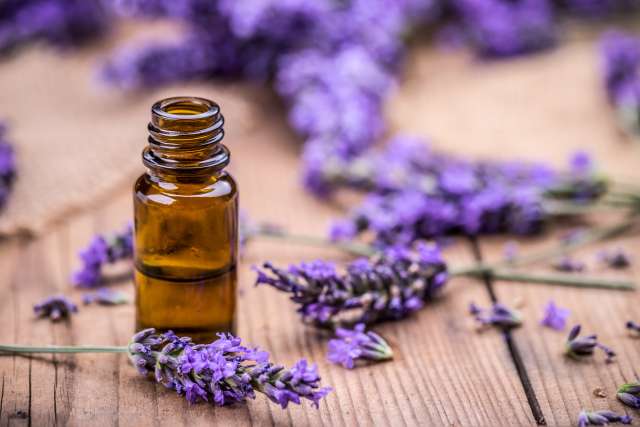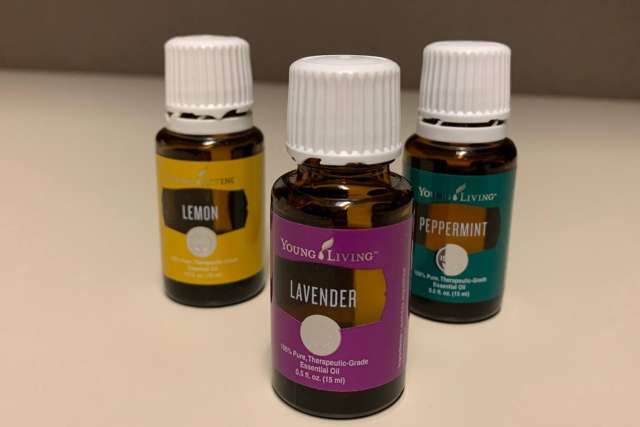Aromatherapy can boost mood and promote relaxation in and out of the hospital setting.
Ambling through a verdant meadow, the crushed lavender blossoms beneath your feet perfume the air with gentle fragrance, bringing a sense of ease and relaxation to your mind.
Only you’re not lolling in a flowery prairie, you’re sitting at your desk. And that soothing scent is coming from the tiny bottle of lavender essential oil from which you just breathed deeply.
Essential oils are not just the stuff of new-age bookstores and hippie hangouts. You might have seen them on the shelf at Whole Foods. Inpatients at UCLA medical centers even may have seen them in their hospital rooms.
A growing body of research attests to the therapeutic value of these plant-derived elixirs, which can be used to relax, energize and soothe body and mind.
“Essential oils have made their way into mainstream practice,” says Elizabeth Ko, MD, medical director of the UCLA Health Integrative Medicine Collaborative. “And it begs the question of the larger practice of integrative medicine, which blends conventional medicine with these non-pharmacologic, evidence-based practices, like essential oils, massage, yoga and acupuncture.”

The power of essential oils lies in their fragrance, she says, which stimulates the brain’s limbic system, responsible for regulating emotion and memory.
What are essential oils?
Essential oils are volatile liquid substances extracted from plants, usually flowers, herbs or trees, Dr. Ko explains. The liquid is extracted through steam distillation or by machine, “and during that process, the fragrance is released, hence the word ‘aromatic.’”
Essential oils are highly concentrated. For example, it takes about 220 pounds of lavender flowers to make one pound of essential oil, Dr. Ko says.
The term aromatherapy refers to using these fragrant plant oils to improve well-being. Chemical components in the oils bind with receptors in the olfactory bulb, one of the structures of the limbic system.
“Essential oils are quickly absorbed by smell receptors that are linked to the limbic system, which controls heart rate, blood pressure, breathing and stress,” Dr. Ko says. “Every plant has a different chemical makeup that affects its smell absorption and its effect.”
How are essential oils used?
These potent plant oils can be inhaled directly — taking a whiff from the bottle or from a cotton ball or tissue drizzled with a couple of drops — or indirectly, through a diffuser that spreads atomized fragrance through the air.
Diluted essential oils may also be used topically by adding a few drops to a carrier oil, such as a vegetable or nut oil, as is often done for aromatherapy massage.
“It’s important to note we do not ingest essential oils,” Dr. Ko says.
While essential oils are not regulated by the U.S. Food and Drug Administration, they are generally recognized as safe when used as recommended, she says.
“Safety testing on essential oils shows very few side effects or risks when they’re used as directed,” Dr. Ko says. “Aromatherapy has a relatively low toxicity profile when administered by inhalation or dilute topical application.”
Essential oils in the hospital setting
Pure essential oils are used with hospitalized patients in UCLA Health medical centers in Santa Monica and Westwood. Wendy Tucker, inpatient integrative medicine coordinator at UCLA Health, says every unit in the hospital is equipped with a set of three essential oils — lavender, lemon and peppermint — which medical personnel can offer to patients.
Tucker and her integrative therapy team provide hospitalized patients with “relaxation services,” which include aromatherapy with essential oils, guided meditation and breath work, gentle in-bed movement and Reiki, a light touch stress-reduction technique.
Aromatherapy may be the most accessible of the available relaxation modalities, she says. It has been offered at UCLA Health for many years.
“I’ll tell patients about the oils and give them the cap to smell,” she says. “If they like the scent, I’ll put one or two drops on a tissue, hold it up for them to inhale and then I’ll just rest the tissue on their shoulder.”
Lavender oil is the most popular in the hospital, Tucker says: “Patients associate lavender with relaxation and that’s why they tend to pick it more often.” Lemon is more uplifting, she says, while peppermint is invigorating.
Popular oils and their effects
The smell of lavender is familiar and calming to many, and it’s also the most-studied essential oil. Lavender interacts with the neurotransmitter GABA to help quiet the mind and the nervous system, Dr. Ko says.
show that lavender oil can improve sleep quality and increase time spent in deep, slow-wave sleep. Another suggests lavender may work as effectively as anti-anxiety medicines such as Xanax or Ativan.
“I encourage my patients who have anxiety disorder or panic disorder to keep close a vial of essential oil,” Dr. Ko says. “And when the temptation hits to pop a pill, pause and take a deep breath with a touch of lavender oil. If it’s effective, then great. If they do need something a little bit more afterwards, at least they tried a lower-risk, lower-cost intervention.”
Aromatherapy with bergamot essential oil, a type of citrus, has been to ease feelings of anxiety and stress. Lemon oil, which smells like ripe fruit, has been to boost mood. Peppermint oil, which has an eye-opening, bright scent, to increase memory and alertness.
Other popular essential oils include cinnamon, chamomile, tea tree and eucalyptus, which one found effective in reducing pain and inflammation.
When shopping for essential oils, look for formulations that are 100% pure, Dr. Ko says. Beware ultra-low prices, as pure oils generally cost at least $10 for a half-ounce bottle.
Effects from essential-oil aromatherapy tend to be short-lived. “It’s not on the order of hours,” Dr. Ko says. “Probably more on the order of minutes.”
Still, a half-ounce bottle will likely last months, even with frequent use, since only a drop or two is needed to produce perceptible fragrance. Be sure to close the cap tightly after each use, as the volatility of essential oils means they evaporate quickly.
With the variety, general safety and increasingly documented efficacy of essential oils, Dr. Ko suggests the curious take an experimental approach to see what smells they like and what feelings are elicited.
““It can be a nice way to explore and play,” she says, “being your own pharmacist.”
Learn more about the UCLA Health Integrative Medicine Collaborative.




